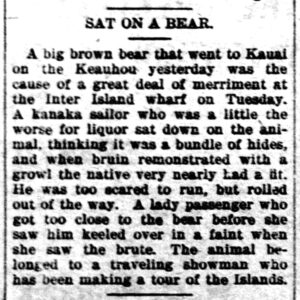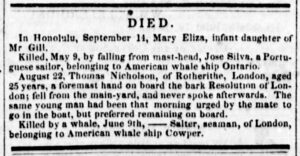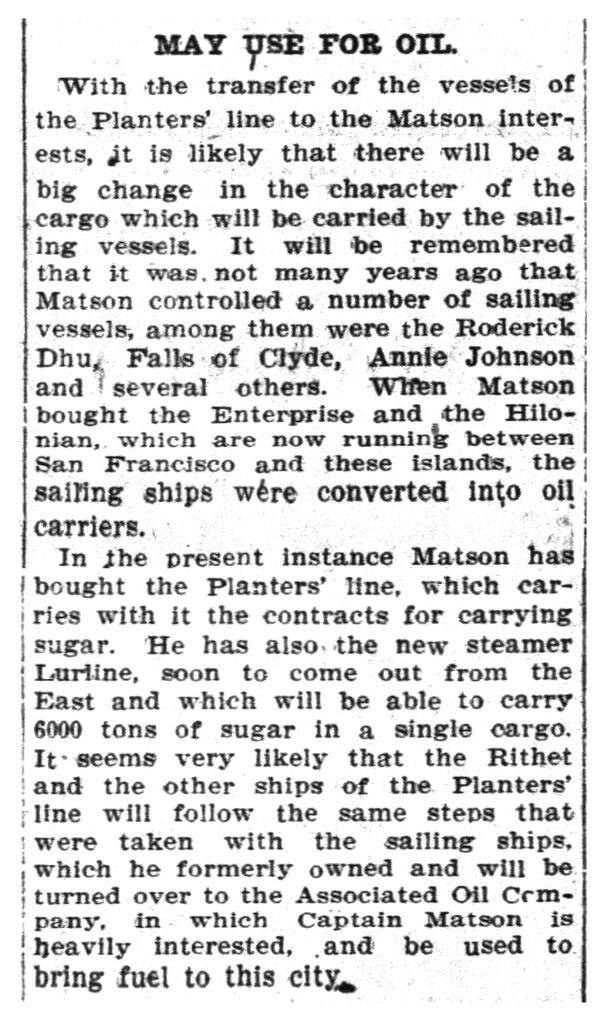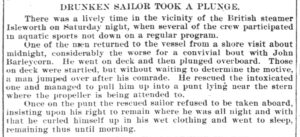Redux: A Place in the History of Hawai‘i
With the disturbing news that DOT Harbors is once again moving to dispose of the National Historic Landmark ship, Falls of Clyde, Maritime Hawai‘i would like to offer this post* from 24 November 2010.
If you are interested in and support the Scottish effort to bring the ship back to Scotland, please see the Falls of Clyde International website for more information.
Most local people do not give cargo ships much thought, until there is a strike (oh no…time to stockpile rice and toilet paper) or a shipping rate increase (ugh…higher prices).
It is no surprise then, that when I “talk story” with folks who show an interest in the Falls of Clyde, I often find that they are not aware of the role the ship played during her days as one of Captain William Matson’s original fleet. They are surprised to learn “that old, rusty ship” once carried cargo to Hawai‘i, as her “great-granddaughters” of Matson’s fleet do today.
Time was when the Falls of Clyde was spoken of in much different terms than she is now.
From the 23 August 1899 edition of the San Francisco Call:
“The big four-masted bark Falls of Clyde will sail to-morrow for Hilo with one of the largest cargoes ever taken to that port. It is not so many years ago since the brig Lurline was considered too big for that trade, and now the big Falls of Clyde cannot carry all the freight offering. The big ship has been luxuriously fitted out for the trade. Cabins and a dining saloon have been built on deck, a steam winch and a donkey engine added to her equipment and other improvements made that make the Falls of Clyde one of the finest vessels in the Hawaiian trade.”
Big. One of the finest.
And what of her cargo? Again, from the San Francisco Call (19 Dec 1902):
“The ship Falls of Clyde sailed yesterday for Hilo with an assorted merchandise cargo, valued at $48,534 and including the following: 40 bbls flour, 2484 ctls barley, 10 ctls wheat, 20,621 lbs bran, 1029 lbs corn, 17,231 lbs middlings, 2590 bales hay, 836,017 lbs fertilizer, 531 lbs bread, 750 lbs salt, 15,000 lbs rice, 447 lbs shrimps, 480 lbs coffee, 268 lbs mill stuffs, 710 lbs sugar, 33 pkgs groceries and provisions, 53 cs canned goods, 25 bbls salt and 25 cs canned salmon, 87 pkgs potatoes and onions, 80 bxs fresh fruit, 1142 gals wine, 120 casks bottled beer, 6 pkgs drugs, 28 pkgs machinery, 200 cs coal oil, 58 pkgs wagon material, 50 bbls lime, 12 pkgs bicycles and sundries, 67 kegs nails, 88 pkgs paper, 3250 gals linseed oil, 35 crts sewing machines, 5 cs shoes, 1000 lbs tobacco, 205 tons coal, 8 horses and 6 mules.”
Note: Based on figures from 2009, the relative worth of $48,534 from 1902 is $1,250,000 (using the Consumer Price Index). Converted using tools at Measuring Worth
If you find yourself at Honolulu Harbor by Pier 7, try to imagine the Falls of Clyde as she once was and think of what she can be again.
***
I thought of her sailing, so hopeful and proud,
The dawn on her sails like a mountain of cloud;
I thought of her battles, none stouter than she,
With the strength and the rage of her rival the sea.
The Ould Has-Been
Cicely Fox Smith
*Redux is a repost of blog content from Maritime Hawai‘i’s creator.






[…] Redux: A Place in the History of Hawai‘i […]